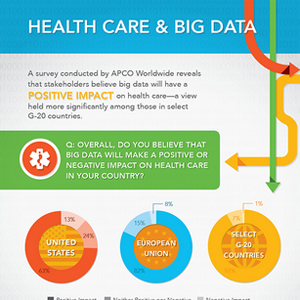For decades, the basis of nearly every medical discovery and research has been about the collection and analysis of data: who gets sick, why do they get sick and why. However, big data has enabled the potential for enormous breakthroughs in this sector.
A recent example of this is, is a study conducted by computer scientists of the Free University in Amsterdam in collaboration with the University Medical Centre Utrecht, which found a new predictor for intestine cancer. The computer scientists looked for distinctive patterns in 263.000 (anonymised) electronic patient records, of which 1292 received the diagnosis of intestine cancer. They compared both groups (cancer versus no cancer) by allowing software to search for the differences in the run-up to the diagnosis. The research has reconfirmed previously known predictors (iron deficiency, age, and constipation) and found one new one: metabolic syndrome, which is a metabolic disorder.
The technique used in this research will, in the near future allow a risk calculation at the desk of the doctor’s office, based on routine patient information of an individual with intestinal complaints. This can help in the decision whether to have the patient examined further or not.
The strength of this new predictive model is that the software uses the electronic patient records data without any bias. It is not programmed in a way to search for specific predictors, as is usually the case in medical research based on data analysis. This causes the model to be applicable on all kinds of data, and therefore it has enormous potential to enhance disease prediction in other diseases, making early detection and intervention possible.
Big data has been known to be beneficial in many industries, often allowing companies to achieve substantial competitive advantage. However, its potential and importance in the healthcare industry exceeds those of other industries since it can actually save lives.
References:
Kop, R., Hoogendoorn, M., Teije, A. T., Büchner, F. L., Slottje, P., Moons, L. M., & Numans, M. E. (2016). Predictive modeling of colorectal cancer using a dedicated pre-processing pipeline on routine electronic medical records. Computers in Biology and Medicine, 76, 30-38. doi:10.1016/j.compbiomed.2016.06.019


Hi Luca! Thanks for your post.
Speaking of big data in the medical industry, I read an article a few days ago about a scientist in Boston who received the $75 million ‘One Brave Idea’ award for his approach towards addressing heart disease. Dr. MacRae’s approach consists of analyzing big data for any associations or traits that could potentially be the cause of coronary heart disease. Although the focus has been on analyzing the older generation in the past, they are now starting to collect data on a younger individual’s sleep, activity and stress levels too – shifting the focus from curing to preventing in the first place. I’m excited about the opportunities that big data has created for us, and quite curious to see what will be discovered in the future!
Link:
– https://www.statnews.com/2016/10/05/one-brave-idea-heart-research/
Hi Shannon, thank you for enlightening me with that article. I believe that the fact that this big data approach towards addressing heart diseases received the $75 million fund, shows us the enormous potential and impact big data is expected to have. I’m very curious how this research will turn out, perhaps it can tell people at an early age to avoid certain things in life to prevent heart diseases at a later age.
Big data is an enormous revolution for medicine development. It’s incredible how humanity will benefit from this.
Data analysis will increase effectively into the process of identifying not only existing deceases but also new ones. The interesting thing with big data is that there exist two types of algorithms (supervised and not supervised).
Applying not supervised algorithms, such as clustering, will mathematically identify different group of people with similar (or closed) qualities. It won’t surprise me to me at all that big data will redefine medical approach by creating more accurate groups of similar people that already have been.
Thanks for this interesting article.